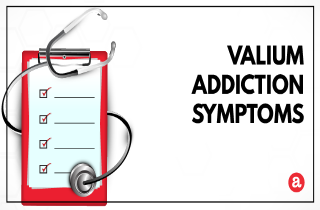Valium (diazepam) is most commonly used to treat anxiety disorders and depression and is said to be both physically and psychologically addictive. Psychological dependence on Valium occurs when you NEED Valium to function normally and crave it when you don’t have it. Learning how to treat Valium withdrawal is just one part of addiction treatment. Like other prescription drugs, treatment Valium addiction includes both physical and psychological therapies.
So, if you are concerned about your Valium use or you have concerns about a loved one, you’re in the right place. Here, we review signs of Valium addiction so that you can identify a problem correctly. Then, we invite your questions about Valium at the end.
Valium addiction signs
The actual time it takes to form a dependency on Valium varies. A person’s body chemistry, the amount and frequency of Valium dosing, and the condition it is treating can all play a role in Valium addiction. Generally, a person taking Valium continuously for 6 months or longer presents a significant chance of becoming dependent on and, in turn, addicted to the drug. But how do you know you’re addicted to Valium?
Symptoms of Valium addiction
There are many signs and symptoms of addiction one can look out for. Some are physical, some are are behavioral, while others are psychological. But if you had to pick one characteristic of Valium addiction, it would have to be loss of control. In other words, when you can’t stop taking Valium even if you wants to, it’s called addiction. The urge is too strong to control, even if you know the drug is causing harm.
So, the main symptom of Valium addiction is uncontrollable, compulsive drug seeking and use, even in the face of negative health and social consequences. Still, if you’re looking for a list of signs and symptoms of Valium addiction, they usually become apparent when Valium use is stopped. Look out for three or more of these clinical diagnostic criteria, occurring at any time in the same 12-month period:
1. Tolerance to Valium (a need for increased amounts of the diazepam to achieve intoxication or desired effect and/or diminished effect with continued use of the same amount of diazepam)
2. Valium withdrawal when diazepam is drastically lowered or stopped, or taking Valium to relieve or avoid withdrawal symptoms
3. Taking Valium in larger amounts or over a longer period than was intended
4. A persistent desire or unsuccessful efforts to cut down or control valium use
5. Spending a great deal of time in activities necessary to obtain, use or recover from Valium
6. Giving up or reducing important social, work, or recreational activities because of Valium use
7. Continuing to use Valium despite knowledge of having a persistent or recurrent physical or psychological problem that is likely to have been caused by or exacerbated by Valium
Valium addiction symptoms: Can they be treated?
YES!
However, getting someone to admit they have a problem with their Valium use is tough. In some cases, the first step to getting help is organizing an intervention for your loved one. An intervention is a process involving family and friends and possibly others who care about a person struggling with addiction. An intervention allows people to gather together to confront the person about the consequences of addiction and ask him or her to accept treatment. This process is not about judging but highlighting and supporting people with addiction to get help.
Still, it’s important not to wait until a Valium addict “wants help.” Instead, think of an intervention as giving your loved one a clear opportunity to make changes before things get worse. If you don’t feel confident to organize an intervention yourself there are some services that offer intervention planning or professional interventionists who can help you.
Once your loved one agrees to seek support, you can begin to consider what type of support they may need. This will depend on the intensity of the addiction to Valium and how well the individual feels they can manage withdrawal.
One of the more important therapies for Valium addiction includes detoxing from Valium. Slow tapering is preferred, as medical staff help you slowly wean off of Valium by reducing the amount of diazepam on a calendar while closely monitoring them. This is because Valium withdrawal can provoke seizures and other complications.
Inpatient treatment – Inpatient treatment may be part of a hospital program or found in special clinics. You’ll sleep at the facility and get therapy in the day or evening. Inpatient valium addiction treatment generally lasts from 3 to 6 weeks. After inpatient treatment, you outpatient treatment, addiction counseling and group therapy is recommended.
Outpatient treatment – Outpatient treatment is usually offered in mental health clinics, counselors’ offices, hospital clinics, or local health department offices. Unlike inpatient treatment, you don’t stay overnight. Outpatient Valium addiction treatment may be a good option if:
- You can’t or don’t want to quit work or take a leave of absence.
- You want to be close to loved ones.
- Inpatient treatment is too expensive.
Help with Valium addiction questions
If you have a question about the signs and symptoms of valium addiction, please ask us below. We do our best to respond to all legimitate inquiries personally and promptly.









Related Posts